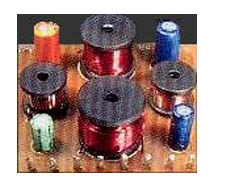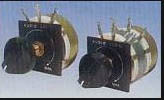Read John’s introduction to crossovers here.
Loudspeaker systems made up of woofer, mid cone and compression driver/tweeter driven by one amplifier are called passive.
Passive refers to the components (inductor and capacitor) between the amplifier and loudspeakers. These components separate the frequencies so bass goes to the woofer and high frequencies to the tweeter.
The capacitor and inductor can be in simple or complex arrangements. Passive crossovers are effective but not accurate, requiring energy from the amplifier to function (insertion loss) they reduce efficiency of the loudspeaker system and contribute distortion especially at high power.
L Inductor mH—(a coil of wire) limits high frequencies going to the woofer.
C Capacitor μF—(like a small instant re-chargeable battery) limits low frequencies to the tweeter.
A single Inductor and Capacitor (6 dB/octave) are used for cheap 2-way speaker systems but does not give sufficient control to accurately manage quality loudspeakers.
An Inductor and Capacitor shifts phase 90 degrees to the loudspeakers in opposite directions.
What is an L-pad?
L-Pad is a level control used in passive loudspeaker systems to attenuate (reduce) power to the tweeter in a 2-way system as well as the mid cone in a 3-way system.
Most mid-range cones and tweeters are approx +6 dB more efficient than woofers. Inside the L-Pad is 2-wire wound elements which are arranged to maintain a constant impedance of 8R to the amplifier.
An L-pad can be purchased as a variable control (single or dual). But variable L-pads are for 8R loudspeakers only. For 4R loudspeakers, use a dual 8R variable L-pad with both sections in parallel. L-pads can also be made with fixed values of large wire wound Resistors. For 4R speakers the value of the Resistors is 1/2.
L-pad fire warning: an L-pad adjusted to attenuate power by -3 dB, will allow 1/2 power to the loudspeaker and the other 1/2 power as heat in the L-pad resistors. The Resistors should be as higher power rating as possible. Not less than 20 watts.



















